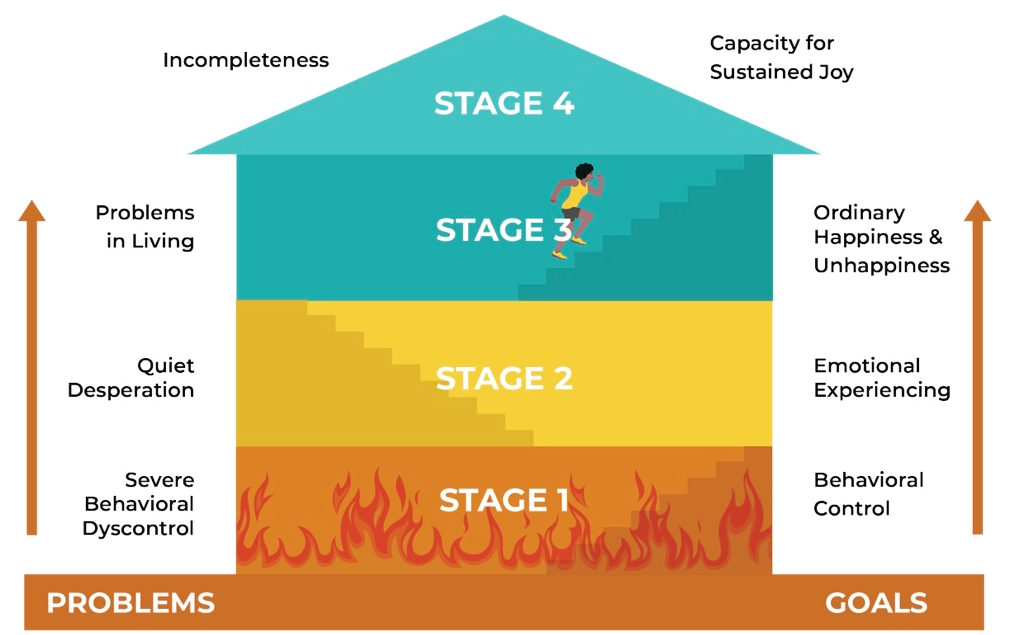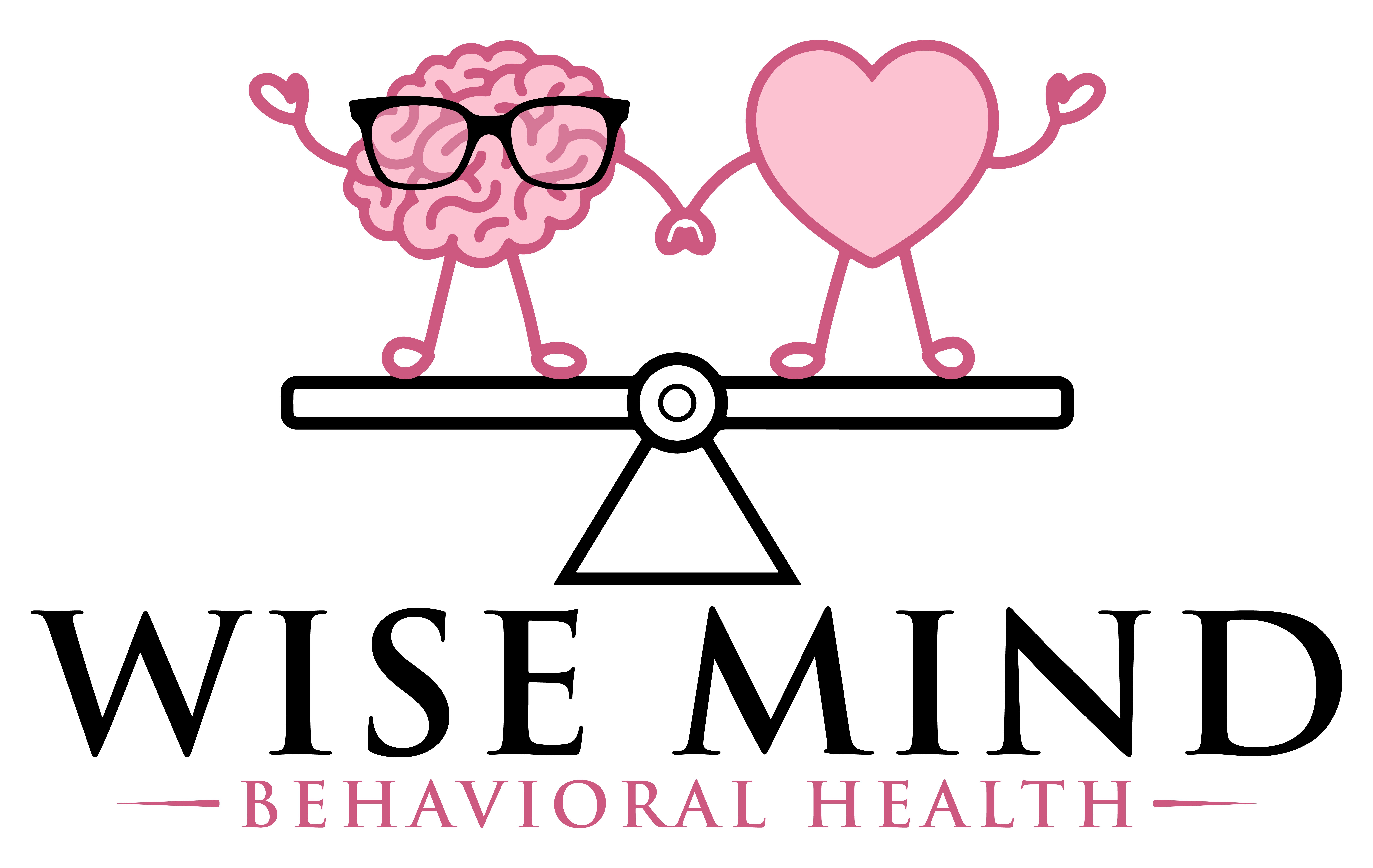WHAT IS
HOUSE OF DBT

The House of DBT is exactly what it sounds like, a house.
- Basement (Stage 1)
- First floor (Stage 2)
- Second floor (Stage 3)
- Roof (Stage 4)
Each level of the house represents stages of treatment and understanding each level is key for improvement and progress in treatment.
*Image and information on the House of DBT attained from Sunrise Residential Treatment Program. For more information visit: https://sunrisertc.com/dbt-house-of-therapy/
In the DBT House of Therapy, the bottom floor is the basement. If you picture the basement, it’s usually a place where there is a lot of fire and pain. It’s a difficult place where no one wants to be, but many people who struggle with emotion dysregulation find themselves stuck there. Those in the basement are usually ones who have suicidal thoughts or even suicide attempts. Self-harm is a regular behavior they engage in. They could be active in an eating disorder or substance abuse. These are examples of behaviors that keep people in the basement.
Challenges
The basement feels like Hell and that it can’t get any worse. So, a lot of clients will accept or at least try to accept they are in Hell. But in Hell, there is no water or relief. In order to feel relief, they participate in behaviors that may temporarily mask their pain. This could consist of self-harming or other self-destructive behaviors.
What happens here?
Another way to describe level one is being out of control. They may engage in out-of-control behaviors, which ultimately makes their life feel out of control. They aren’t functioning in daily life. The effect of their mental illness has taken over.
Common Behaviors
One of the common things seen with clients is that, in their mind, the illness comes to define who they are. It’s hard for them to separate pathology and behavior from who they really are. It’s difficult to do because “I am my illness” has become their mantra for so long.
Reference:
DBT House of Therapy: A Guide to Treatment for Your Daughter. https://sunrisertc.com/dbt-house-of-therapy/
Overview
Once clients get out of the basement level, they notice it’s not as bad as Hell, but it’s still not comfortable. The floor is still hot and there’s still no water or sense of relief.
Challenges
They can’t get relief because the main thing that has changed in this stage is they have stopped a lot of out-of-control behaviors. Self-harming and suicidal behaviors are no longer happening.
What happens here?
With not having any water or relief, the client’s anxiety levels start to rise. They are not burning but they are exhausted. They have given up behaviors that gave them temporary relief. It wasn’t permanent relief, but it was at least some relief.
Common Behaviors
Even families will experience their own anxiety. As the client improves, the roles in the family start to change. Their anxiety goes up because they haven’t operated at this level before. It is common for clients to go back and forth from the basement to the first floor during the beginning few months of treatment. It is important to keep in mind that everyone progresses at different speeds and temporary regression is to be expected at times.
Reference:
DBT House of Therapy: A Guide to Treatment for Your Daughter. https://sunrisertc.com/dbt-house-of-therapy/
Overview
As clients deal with some of those behaviors getting in the way, they move to stage 3, which is the second floor of the House of DBT. This is where we work on the behaviors interfering with their quality of life.
Challenges
The challenges here are often poor relationships—not being well connected or being intimidated to get close to people because It’s scary for them.
What happens here?
As they are in this stage of treatment, the difference on this floor is that there IS water. Therefore, the client starts to find some relief. They learn coping skills and have been participating in DBT skills training. These skills include mindfulness, distress tolerance, emotion regulation, and interpersonal effectiveness (and Walking the Middle Path in DBT-A).
Common Behaviors
As clients are learning to better manage their emotions, it's not uncommon that they get some relief, which triggers nervousness and fear. Often, it’s a life they’ve never quite lived, so there are a lot of unknowns that bring anxiety. Fear may lead to them going back down to Hell because, even though it is miserable, it's familiar.
Reference:
DBT House of Therapy: A Guide to Treatment for Your Daughter. https://sunrisertc.com/dbt-house-of-therapy/
Overview
The last floor in the DBT is the roof. Every house has a roof and when you get on it, the view is amazing! Your perspective is changed.
Challenges
You are now open to every weather pattern that may come into your life. So, at some point radical joy and acceptance must take place. This is a difficult stage to get to and it takes time.
What happens here?
It’s essentially being able to accept the experiences and feelings that come into your life much like the rain or the sun. We experience pain and loss, but we can also experience joy. Both exist and can co-exist. We don’t have to go back to those self-destructive behaviors in Hell.
Common Behaviors
Those on the roof have developed strong and healthy coping skills. They have learned how to accept pain and joy. They don’t participate in self-destructive behaviors anymore, but rather a sense of self-compassion and fulfillment in healthy relationships.
Reference:
DBT House of Therapy: A Guide to Treatment for Your Daughter. https://sunrisertc.com/dbt-house-of-therapy/
